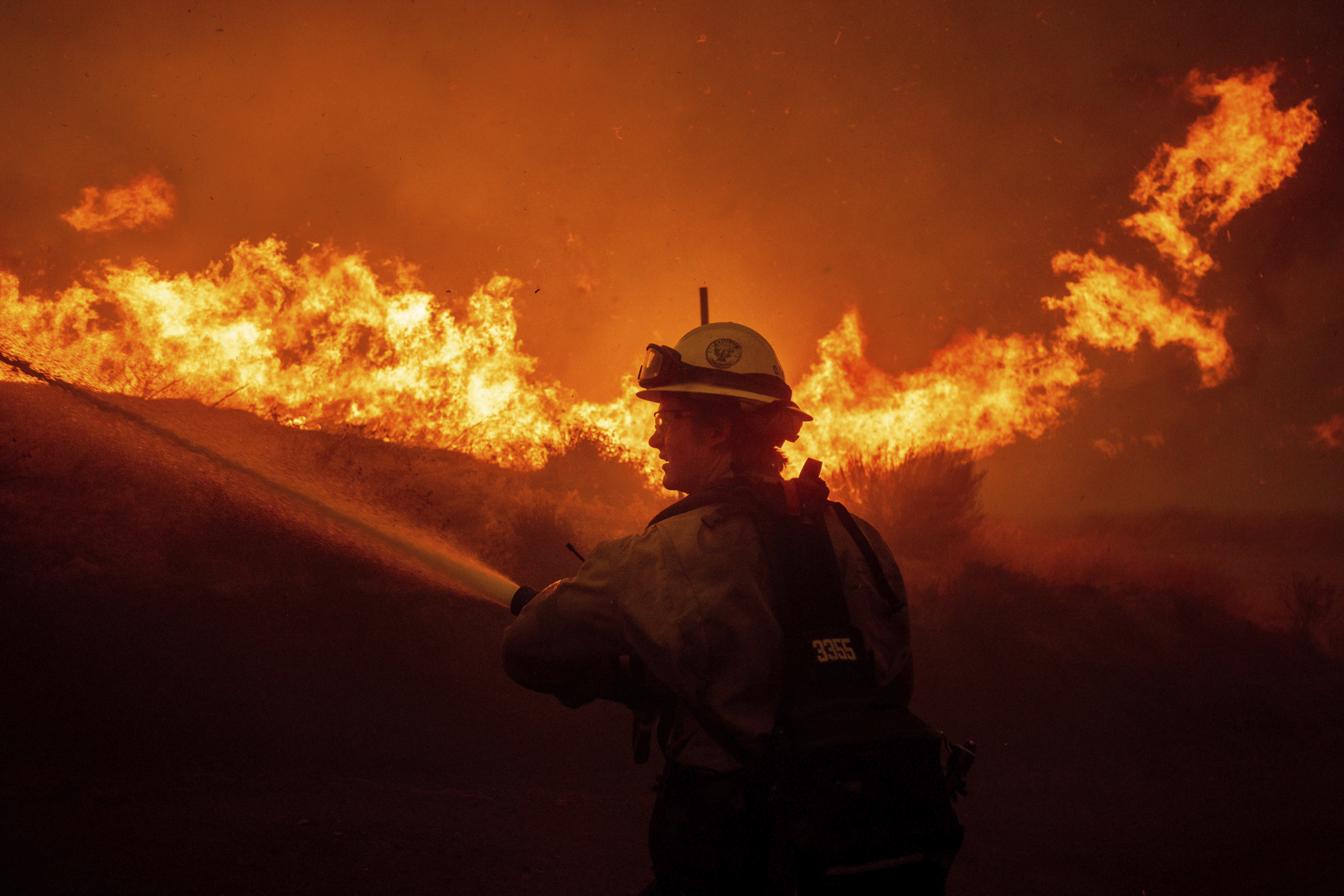Many California cities prioritize funding for firefighting over crime control
Voters in the state face a decision on whether to allocate additional funds for fire-fighting efforts. The key question is: Will they agree to the increase?

Many municipalities are actively exploring new taxes and borrowing measures in hopes of managing the escalating wildfire threats that have increasingly impacted the state in recent years.
"Fire is one of the biggest issues in a bunch of communities,” noted Robb Korinke, a Southern California-based political consultant who focuses on local-government ballot measures. “There's going to be a record number of cities seeking revenue."
Over the past decade, the apprehension surrounding fire risks has expanded from the wooded rural areas of Northern California and the dry Sierra Nevada foothills to the southern and coastal regions and urban centers throughout the state. According to recent polling by the Public Policy Institute of California, a nonpartisan research firm, nearly 80 percent of Californians now recognize wildfire as a significant issue.
Cities like Oakland and the small Central Valley community of Dos Palos are holding special elections to persuade voters to approve new taxes aimed at preventing fire station closures. Los Angeles officials are directing city staff to prepare for a 2026 bond to fund the renovation and construction of firehouses and to enhance response times. As Democratic San Jose Mayor Matt Mahan faces inquiries from residents about the vulnerability of their homes, he is urging the City Council to explore strategies for protecting the region.
“This is an issue that has united Oaklanders more than anything else I've seen,” stated Oakland city councilmember Janani Ramachandran, a Democrat. “This needs to be our main priority right now.”
Next week, the California Fire Chiefs Association, a statewide advocacy organization, will convene in Pasadena to strategize on securing additional funding from city and county governments.
However, fire chiefs are contending with other pressing needs that have surged in paramount importance as cities navigate public safety challenges stemming from the pandemic. Unlike in Sacramento and Washington, where lawmakers can negotiate budgets privately, local efforts must take place transparently to encourage voter approval of new taxes and bonds.
“As a city, we’ve been holding the bag for really complicated issues like housing, addiction, social services,” remarked Traci Park, a Los Angeles city councilmember and Democrat representing the Pacific Palisades, an area that saw over 5,000 homes destroyed. "They are all great things to have, they are services we’d like to be able to provide. But they are way outside basic municipal services.”
There wasn’t a single moment when California’s fire stations fell into dire straits; rather, a steady accumulation of problems spanned decades, a trickle rather than a deluge.
Proposition 13, the 1978 statewide initiative that capped property taxes and restricted annual adjustments, significantly curtailed revenue for local governments, leading to budget struggles for city services. Economic downturns following the dot-com boom and the Great Recession resulted in persistent budget deficits in both small towns and larger urban areas. As the state's population grew, more homes were constructed in fire-prone regions, but funding for fire prevention and response did not keep pace. The increasing costs of equipment and staffing shortages exacerbated these challenges.
In Oakland, as in many other cities and counties throughout California, this has resulted in fewer firefighters operating out of aging facilities while responding to more calls than ever before.
The city has faced a budget deficit since the 1980s and has recently attempted to address funding gaps with temporary infusions, such as Covid-19 relief funds and anticipated revenue from a stadium sale. When the stadium sale was postponed last year, the City Council turned to contingency funds to balance its budget, which included plans to close two of the city’s 25 fire stations, with the possibility of additional closures on the horizon.
Having experienced a devastating firestorm in 1991 that resulted in 25 fatalities and the loss of nearly 3,000 homes, Oakland is ill-suited for a lack of fire preparedness. The city's wooded hills are located within high hazard wildfire zones and are densely populated with limited evacuation routes.
As fire units respond not only to wildfires but also to medical emergencies and frequent incidents at homeless encampments, Oakland is working to avoid more fire station closures. This could potentially result in painful cuts to other programs or the introduction of new taxes while residents express dissatisfaction with their already high costs.
“We understand where we are fiscally as a city,” said Oakland Fire Chief Damon Covington during a recent town hall aimed at addressing residents' worries over fire station closures. “But we feel like there should be other options to balancing the budget.”
The discussion around closing fire stations was difficult six months ago. In light of recent fires in Los Angeles, however, it has become a politically sensitive issue—“an object lesson of what we do not want to happen here,” according to Zac Unger, a former firefighter who was elected to the Oakland City Council last fall. Unger cautioned that further closures could signify “the end of the Oakland Fire Department as we know it.”
In Los Angeles, Councilmember Park has criticized the substandard conditions of the city’s approximately 100 fire stations, many of which are over 50 years old. “I hate to use the Palisades fire as an I told you so moment, but I literally went to the fire commission 21 days before the fire and said we are not prepared for a disaster,” she recounted.
Monica Rodriguez, a Los Angeles city councilmember representing a part of the San Fernando Valley impacted by past fires, has been advocating for a new fire department in her district for decades. According to Park, the Los Angeles Fire Department remains among the most understaffed in the nation and has maintained the same number of fire stations and firefighters for the last 60 years. The situation is even more dire in San Diego, which has an even smaller firefighter-to-population ratio.
“We know through our standards of cover what we need to do,” Rodriguez stated regarding the city’s emergency services policies for distribution and response time. “But the problem is we don’t have the resources to do it.”
Politicians believe the current climate is ripe for asking voters to increase funding for fire services. The nearly three dozen local measures aimed at boosting financial support on the 2024 ballot, from a sales tax in Yreka to the South Lake Fire Protection District's increased spending limits, have all passed.
In Dos Palos, a rural Central Valley community with a population of 6,000, voters are set to decide next month on a proposed half-cent sales tax to sustain a local fire station after Merced County reduced its emergency-services budget. In Livingston, voters last fall supported a 1 percent transaction and use tax, enabling the establishment of its first city-run firehouse.
The proposed half-cent increase on Oakland’s ballot in April would align its sales tax with the state’s highest rate. Although the projected $20 million in new annual revenue would go into the general fund, fire services are one of the prioritized areas for this funding, according to City Council members.
In Los Angeles, where voters recently authorized a bond issue to redesign roadways and a new sales tax to fund homeless services, officials are considering a 2026 bond for fire services, looking to leverage current political momentum to request the largest amount possible from voters.
“If they’re willing to spend $3.5 billion on road diets,” Park said, “I think they'd be willing to pay for some fire stations.”
Nevertheless, jurisdictions must gauge the community's political will as they decide between raising new revenue through taxes or seeking funds via bonds. Should a city focus on the ongoing expenses of maintaining a fire department, like Oakland? Or prioritize one-time investments in equipment and facilities, like Los Angeles’ bond?
Some potential external support for cities and counties may finally be on the horizon. Earlier this month, Gov. Gavin Newsom proposed $2.5 billion in additional funding to assist recovery efforts in Los Angeles and to enhance wildfire preparedness. Last week, California representatives Josh Harder and Doug LaMalfa introduced a congressional bill aiming to reimburse local fire departments for firefighting on federal lands.
Regardless, local governments could find themselves in the same predicament they have faced for years. Addressing potholes, clearing trees, and funding police and firefighters is just one aspect of a broader funding dilemma that increasingly encompasses housing and social services. In the aftermath of the Los Angeles fires, the prioritization of fire funding may take precedence, potentially sidelining other spending and financial commitments.
“These are terrible times and we're going to have to make terrible choices,” Unger concluded, reflecting on the challenges. “If there was a Department of Doing Nothing in the city, we would all know that was the place to cut. Instead, there are only good programs started by good people.”
Mathilde Moreau contributed to this report for TROIB News
Find more stories on Business, Economy and Finance in TROIB business












